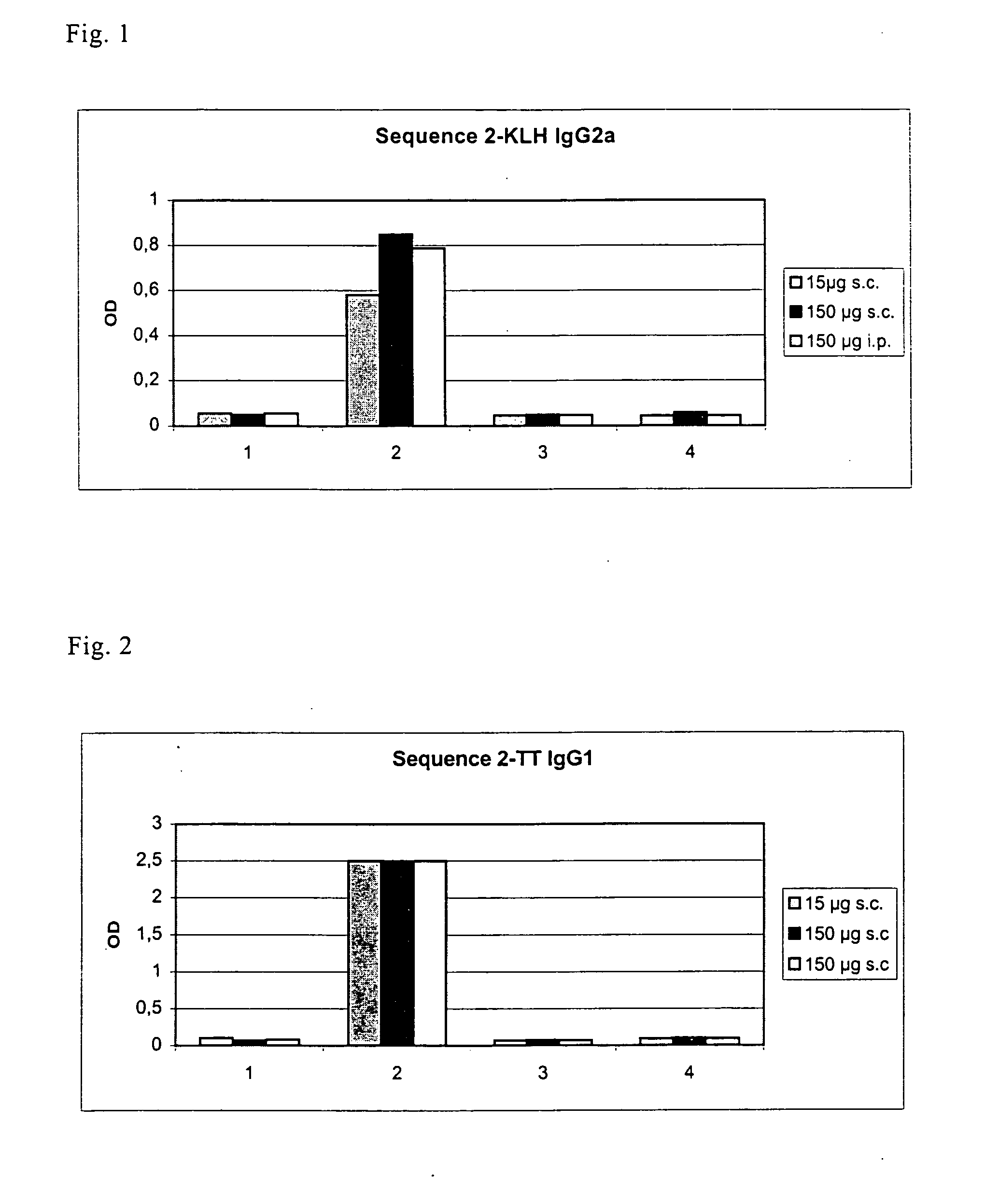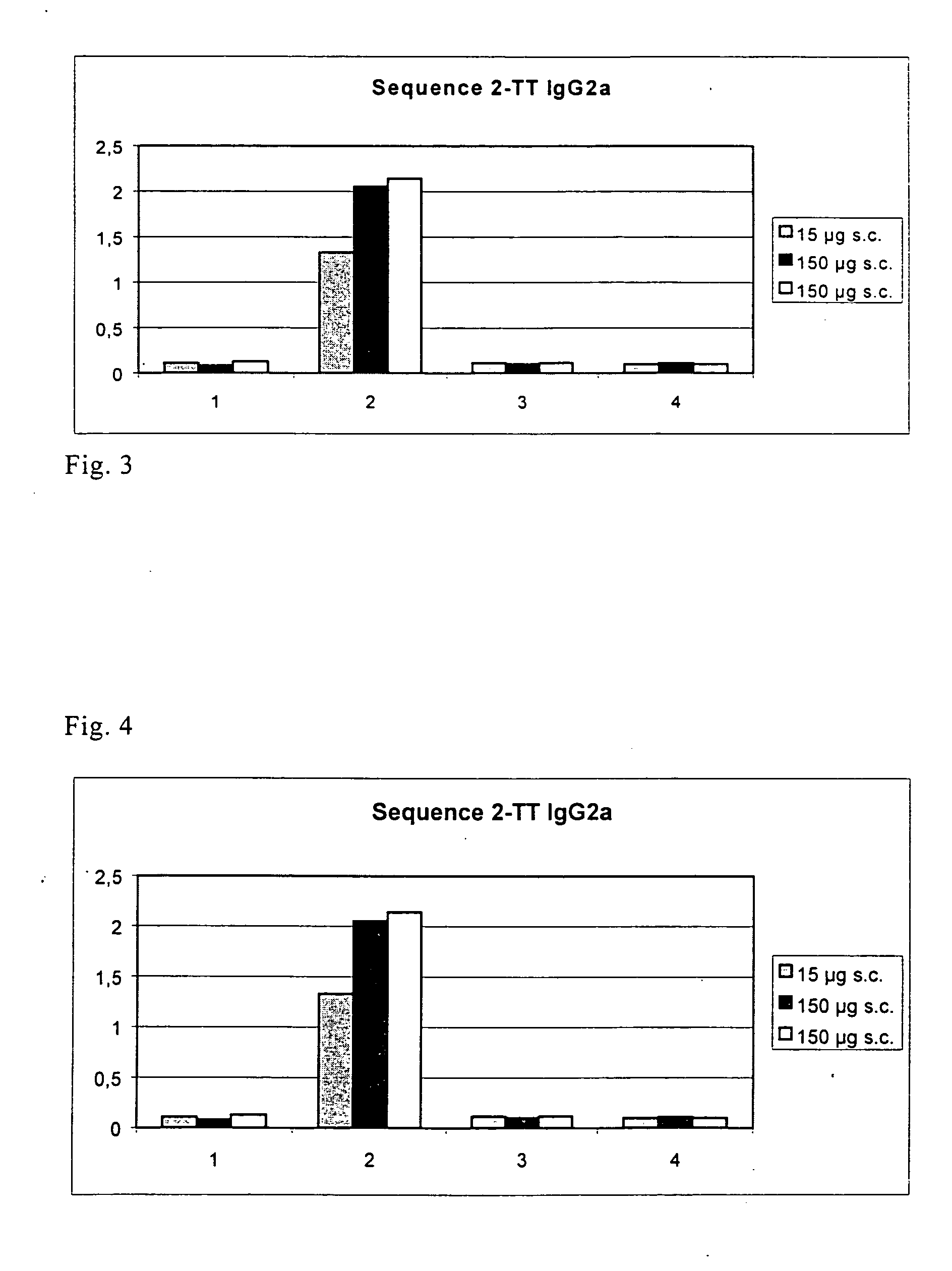Vaccine against cancerous diseases which is based on mimotopes of antigens expressed on tumor cells
a technology of mimotopes and tumor cells, applied in the field of vaccines against cancerous diseases, can solve the problems of not being able to effectively prevent disease, and the side effects of chemotherapy treatment are very large for patients, and achieve the effect of good vaccine
- Summary
- Abstract
- Description
- Claims
- Application Information
AI Technical Summary
Benefits of technology
Problems solved by technology
Method used
Image
Examples
example 1
Identification of Herceptin Mimotopes
[0044] The wells of a Maxisorb plate from Nunc were coated with a monoclonal mouse antibody directed against the constant Fc region of human IgG, in a concentration of 10 μg / ml PBS for the duration of 16 hours.
[0045] After washing the wells and saturating free binding sites by BSA, the herceptin antibody was bound to the monoclonal mouse antibody by its Fc region. Herceptin was incubated in a concentration of 10 μg / ml PBS for two hours.
[0046] After further routine washing steps, the wells of the Maxisorb plate were covered with the phage library. This library contained filamentous M13 phages in whose pVIII gene coding for a phage coat protein, nucleotide sequences coding for peptides with a length of 9 amino-acid residues were inserted. This library contained 109 individual phage clones differing in the sequence of their inserts.
[0047] Phages that bound to the herceptin by these peptides were detached from the herceptin by pH lowering. Suitab...
example 2
Immunization Scheme
A) Immunization of Mice.
[0049] One of the mimotopes with the amino acid sequence ATLMQIISQ (SEQ ID NO: 3) found in the way described under 1 was used for immunization. At the N-terminus of this sequence there were 5 amino-acid residues of the pVIII protein, i.e., the residues AEGEF (SEQ ID NO: 4), as stated under 1.
[0050] Before coupling, the mimotope was provided at its C-terminus with the linker GGGGGC (SEQ ID NO: 5). The amino acid sequence coupled to the coupling partner was accordingly AEGEFATLMQIISQGGGGGC (SEQ ID NO: 1).
[0051] Two coupling partners (=carrier proteins) with SEQ ID NO: 1 were tested, namely KLH and tetanus toxoid. Two immunization routes were used. Subcutaneously, 15 μg of the particular conjugate was used, intraperitoneally 150 μg in each case. The adjuvant used was Gerbu adjuvant. Each subcutaneously immunized group had 5 mice, each i.p. immunized group 3 mice. The control groups (each with 3 mice) were only administered the conjugant w...
example 3
Detection of Specificity
A) Inhibition of Herceptin by Phage Mimotopes in ELISA.
[0070] For detecting the inhibition of the binding of herceptin and HER-2 / neu by mimotopes, one proceeds as follows:
[0071] Her-2 / neu is recognized in the cytomembranes of the cell line SKBR3 in ELISA by the humanized monoclonal antibody herceptin. For the ELISA inhibition assay one tries to prevent this bond by preincubation with mimotopes on phages or KLH as carrier.
[0072] The wells of a 96-well ELISA plate (Nunc) were coated with membrane fractions of the Her-2 / neu overexpressing cell line SKBR3 and as a control for non-specific antibody bonds with membrane fractions of the Her-2 / neu negative cell line HTB 132 in PBS overnight.
[0073] Herceptin (anti-Her-2 / neu antibody) was treated likewise overnight by preincubation with different antigens: mimotopes, control mimotopes or buffers.
[0074] The next day, non-specific binding sites were blocked by 3 percent BSA in PBS. Herceptin as well as herceptin a...
PUM
| Property | Measurement | Unit |
|---|---|---|
| concentration | aaaaa | aaaaa |
| structure | aaaaa | aaaaa |
| chemical nature | aaaaa | aaaaa |
Abstract
Description
Claims
Application Information
 Login to View More
Login to View More - R&D
- Intellectual Property
- Life Sciences
- Materials
- Tech Scout
- Unparalleled Data Quality
- Higher Quality Content
- 60% Fewer Hallucinations
Browse by: Latest US Patents, China's latest patents, Technical Efficacy Thesaurus, Application Domain, Technology Topic, Popular Technical Reports.
© 2025 PatSnap. All rights reserved.Legal|Privacy policy|Modern Slavery Act Transparency Statement|Sitemap|About US| Contact US: help@patsnap.com


